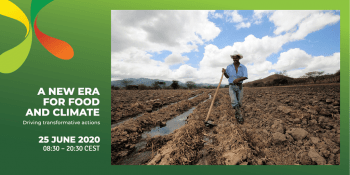Food is our common ground: diets, land use and emissions

Cliquez pour la version française
by Sonja Vermeulen
One inconvenient truth about food and climate change is that total emissions from agriculture must increase to feed growing populations with changing dietary demands. Indeed, the widely cited estimate from the Food and Agriculture Organisation of the United Nations (FAO) that we will need 70% more food by 2050 has recently been revised upwards to 100% +/- 11%. A more detailed picture of the future size and shape of this food demand emerges in Global changes in diets and the consequences for land requirements for food, by Thomas Kastner, Maria Jose Ibarrola Rivas, Wolfgang Koch and Sanderine Nonhebel, a recent article that presents historical FAO datasets in a new format.
Kastner and co-authors’ innovation is to calculate and show how our total calorie consumption is divided among different types of food, and then how much land is required for each of these food types, both for the world as a whole and for each of 17 major geographic regions. The consumption data alone provide a fascinating portrait of global nutritional diversity. Did you know, for instance, that Central Africans are the world-record root-eaters, and Southern Europeans the world-record fruit-eaters
The analysis busts the myth that diets are rapidly becoming richer across all developing countries, moving towards a static, Western endpoint. The reality is that developing regions vary widely in their trajectories – most sobering is the marked decline in average calorific intake across “Middle Africa” over the past half century. Plus Western diets are in flux. For example, North American calorie consumption has increased markedly since 1961, mainly due to rising use of sugars and vegetable fats rather than of animal products, which have remained constant at about 1000 calories per capita.
Extrapolating from consumption to land use provides further insights. Particularly interesting is that between 1963 and 1984, expansions in land requirements for crops were largely associated with population growth, and for many regions were compensated by land savings due to improving technology. After 1984 a greater proportion of agricultural expansion was associated with changes in diets, and technology was less successful as a buffer.
What of the future? The authors caution that feeding nine billion people at the levels of consumption found in North America, Oceania and Europe will require a doubling of current cropland, and further that technology-based land savings are usually based on much higher inputs of fossil fuels, fertilizers, pesticides and irrigation infrastructure. Also, the study under-represents the true extent of land and resource use for human food production, as the FAO data do not include pastureland for grass-fed livestock, nor fisheries.
In short, unless there are severe curbs on high-end food consumption (along the lines of permanent wartime rations), food-related emissions will rise, through a combination of land conversion and more input-intensive farming. But the good news is our impressive capacity for adaptation: as the authors’ analyses show, human diets are not on a one-way demand-driven path, but instead are surprisingly flexible over time, influenced by what’s most available and affordable locally and through trade.
Links
- Bruinsma, J. 2009. The resource outlook to 2050: by how much do land, water and crop yields need to increase by 2050? Paper presented at the FAO Expert Meeting, 24-26 June 2009, Rome on “How to Feed the World in 2050”.
- Tilman, D., Balzer, C., Hill, J. and Befort, B.L. 2011. Global food demand and the sustainable intensification of agriculture. Proceedings of the National Academy of Sciences 108: 20260-20264. DOI: 10.1073/pnas.1116437108.
- Kastner, T., Ibarrola Rivas, M.J., Koch, W. and Nonhebel, S. 2012. Global changes in diets and the consequences for land requirements for food. Proceedings of the National Academy of Sciences 109: 6868-6872. DOI: 10.1073/pnas.1117054109 [subscription required]
This is the June 2012 installation of AgClim Letters, a monthly e-bulletin on science and policy written by Sonja Vermeulen, Head of Research for CCAFS. Sign up to receive AgClim Letters bulletin and read past bulletins. Your comments are welcome below.


